A non-invasive manual method for the assessment of pregnancy in female Scyliorhinus canicula catsharks

Abstract
Enhanced survival of oviparous shark populations can rely on only one easily applicable method. We tested a powerful method to retrieve egg cases from dead oviparous females at the fish market which is non-invasive. We approved this method for Scyliorhinus canicula and Scyliorhinus stellaris (smallspotted catshark and Nursehound) in Valletta, Malta in 2014. Here, catsharks are landed in whole, whereas in many other Mediterranean countries sharks are already eviscerated when brought ashore. Saving egg cases bears the grateful opportunity to rescue shark embryos and this then helps again to restore fish stocks. The common work flow of fishermen is to throw away the egg cases when eviscerating the shark and so the embryos were left in the bin to die. To apply a non-invasive method is very important at fish markets where sharks are landed in one piece as fish brokers do not tolerate many dissections. So, our goal was to detect pregnant females with maximum accuracy and dissect only females with egg cases inside. Formerly, the common method used by members of Sharklab-Malta was to dissect females more or less randomly based on only two parameters (i) a total length above 40cm and (ii) a relatively corpulent body shape. This was not effective as many females were dissected without containing egg cases. This led to the more problematic fact that pregnant individuals were not found and so their offspring died in the end. The basic concept in our newly tested method is based on using a fixed touching pattern which allows to screen the belly of all females available simply by hand. To screen one female only 2 seconds are needed, and this works surprisingly well. We called this method “gotIt” simply because we got all available egg cases and could save all embryos. A validation underpinned the success and showed that gotIt works with 100% accuracy. After rescuing the egg cases they were transported to an aquarium. Egg cases were attached to a lanyard by their tendrils and left for development in the tank for 3-6 months (depending on their initial developmental stage at the fish market) at a water temperature of 15-19°C. After hatching, sharks were fed with squid and released into the sea. The number of rescued embryos arose significantly from five to above hundreds of shark pups which were saved and released by applying gotIt. Additionally, fishermen can be encouraged to use this method, as awareness programs can be promoted to encourage consumption of this sustainable fish, which can therefore increase the marketable prices. Widely applied, gotIt can help to preserve oviparous shark populations at fish markets where sharks are landed whole.
Article Details
- How to Cite
-
HOF, M., DAHLKE, R. I., DANDEKAR, T., KALTDORF, M., & BECK, L. A. (2018). A non-invasive manual method for the assessment of pregnancy in female Scyliorhinus canicula catsharks. Mediterranean Marine Science, 19(1), 201–208. https://doi.org/10.12681/mms.13838
- Issue
- Vol. 19 No. 1 (2018)
- Section
- Research Article
Authors who publish with this journal agree to the following terms:
- Authors retain copyright and grant the journal right of first publication with the work simultaneously licensed under a Creative Commons Attribution Non-Commercial License that allows others to share the work with an acknowledgement of the work's authorship and initial publication in this journal.
- Authors are able to enter into separate, additional contractual arrangements for the non-exclusive distribution of the journal's published version of the work (e.g. post it to an institutional repository or publish it in a book), with an acknowledgement of its initial publication in this journal.
- Authors are permitted and encouraged to post their work online (preferably in institutional repositories or on their website) prior to and during the submission process, as it can lead to productive exchanges, as well as earlier and greater citation of published work (See The Effect of Open Access).




